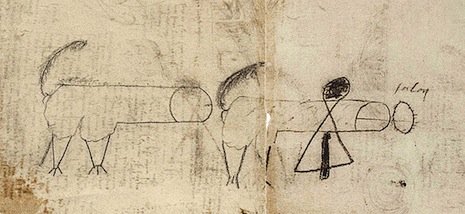When your art is so good, you must be straight
A brief dwelling on homophobia in art history
Although scholarly research has the privilege of having the reputation of being neutral, it never is. Research is done by humans, and humans are tied to their preconceptions about life. This counts for all fields, including art history. One of the biggest reasons for us to start this platform was that we noticed queer art and artists are often excluded from the canon, or their queerness is hidden from the public.
I thought this happened in a silent way, that it is just the status quo. But I first stumbled upon a very intentional moment of erasure while writing my bachelor thesis about Benvenuto Cellini’s Perseus (1545-1554). When writing about Renaissance sculpture in Florence, one is bound to talk about Donatello. His bronze sculpture of David (c. 1440) is not only celebrated as a revolutionary piece of art, but it has also become a homosexual icon. So there I was, reading ‘Donatello: Sculptor’ by John Pope-Henessy, one of the classics in this field, and finding out that apparently Donatello could not have been gay ‘because his art is too good’. According to Pope-Henessy, homosexual interpretations of Donatello’s David had ‘left a trail of slime’ on a great artwork. Mind you, this was said in the 1980’s. The message is clear: homosexuality is innately bad. So bad, that homosexual individuals are incapable of producing anything of quality. A fascinating detail is that Pope-Henessy identified as homosexual himself.
Donatello, David, c. 1440, Bargello, Florence
Let it be known that this sentiment is decreasing in popularity, but is still present. A recent example is provided by French scholar Jacques Bouineau. In his essay Antiquité, Art et Politique (2016) he argues that Leonardo da Vinci could not have been gay. Before we get into his reasoning, I will provide some queer context. Leonardo had an assistant, Gian Giacomo Caprotti da Oreno, who he lovingly called Salai (from Salaino, which means little devil). Salai famously stole from and lied to Leonardo. For instance, he would sell valuable belongings to buy expensive clothing. However, they worked together for about thirty years. An erotic drawing can be found by Leonardo’s hand, dated around 1513, with Salai’s name crossed out on the back. Another drawing can be found in one of his sketchbooks, where two penises on legs appear to be walking towards a floating hole with Salai’s name above it. There are also court documents that show that Leonardo had been accused of sodomy. In short, there is evidence to support that Leonardo was queer. Bouineau’s argues that Salai and Leonardo could not have been sexually or romantically interested in each other, because ‘they got along too well’. This not only indicates the worrying idea that everyone inherently hates their significant other (hence why I found this argument on r/AreTheStraightsOK), but also erases Leonardo’s queerness.
Drawing from one of Leonardo's sketchbooks.
So why does it matter whether an artist was queer or not? I can answer that with a similar question. Why is it so important to negate an artist’s queerness? Why does queerness devalue and artwork so much, that what is seen as the most important pieces of art would lose their status by its presence? Why is queerness something that should be hidden, ignored or disproven? When these texts are being used while left unchallenged, and queerness is excluded from art education, the associations of homosexuality with negative characteristics freely continues. And on top of that, the reasoning behind these comments are very rudimentary. ‘His art is too good’ and ‘they actually liked each other’s company’ are not very valid or sound arguments. One would expect differently from, for instance, one the most well-known scholars on Italian Renaissance art.
Leonardo da Vinci, St. John the Baptist (detail), 1513-1516, Louvre, Paris (modelled after Salai)
There are places where Leonardo’s relationship with Salai is respected. For example, it was a revelation to play Assassin’s Creed Brotherhood (2010) and seeing the relationship between Leonardo and Salai acknowledged, while portraying Leonardo as one of the closest friends of the main character. How come it is easier for a video game, which exists within a realm veiled with toxic masculinity and heteronormativity as we touched upon earlier, to accept an artist’s homosexuality, than it is for ‘objective’ scholarly field to do so?
Main character Ezio Auditore and Salai in Leonardo's workshop, Assassin's Creed Brotherhood, 2010
This is a very brief look, with limited examples, at how queerness has been treated in art historical research. It only focuses on the erasure of Western, white, male, cis homosexuality. There are a lot more examples of queerphobia, but luckily there is also a vast amount of researchers with opposing views. As a field, we should work towards a more critical interpretation of our sources, and try to resolve any bigoted connotations we might have towards marginalized groups. Otherwise we are forced to take seriously a ‘because I said so’ line of thinking, which benefits no-one.




